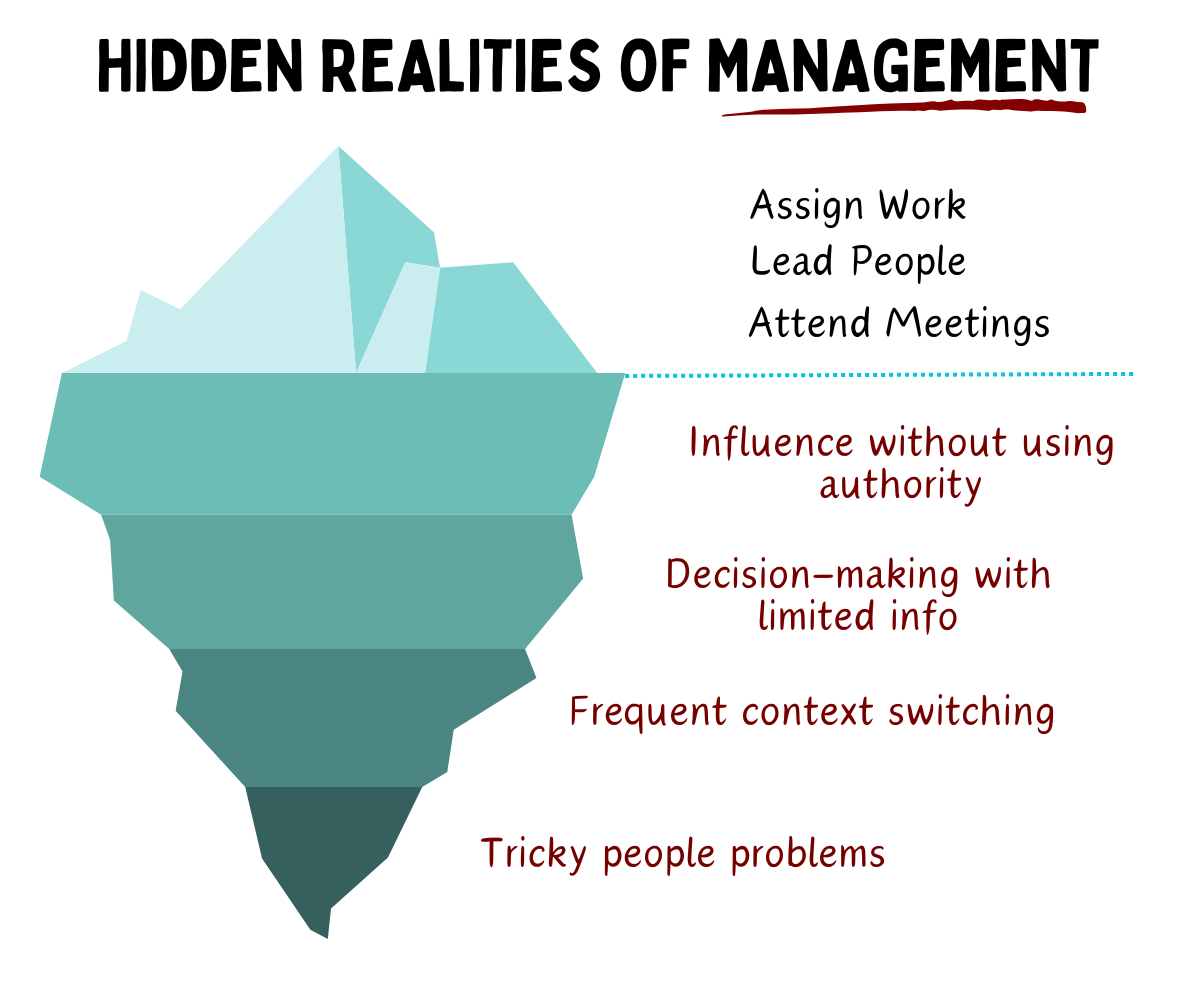Intro
Today’s article is a guest post by
, Senior Engineering Manager at Salesforce, and a fellow author at Diary of an Engineering Manager (subscribe if you haven’t!).Suresh and I have been chatting about the path from Senior Engineer to Management, a path I had once considered. I wanted him to share more about his learnings and challenges faced growing into a manager, now that he’s been one for several years. He graciously agreed and is here to share his story today.
Without further ado, here’s Suresh’s story.
Hi, I’m Suresh.
If you’re an engineer thinking about becoming a manager someday, here’s a heads-up. What you see from the outside, by watching your manager or reading leadership books, is just the tip of the iceberg.
As a developer productivity engineer, I had all these improvement ideas: automate processes, collect more metrics, deprecate legacy systems. I remember thinking, “If only I were the Engineering Manager, I’d make all this happen in no time.” Well, fast-forward a few months, I became the same team's EM. Did all my brilliant plans come to life? Not exactly.
Why not?
Well, I overestimated the power of the EM title. Having ideas is one thing; getting the team to buy in and execute on them is a whole different challenge. There’s a lot about management you only see once you’re in the trenches.
After three years in this role, I’ve learned a few things the hard way. Here are four hidden realities of engineering management, and how you can prepare for them even in your current role as an IC.
1. Authority Only Gets You So Far
I’m not talking about “authority” as in technical expertise but rather the expectation that your team will listen simply because you say so.
When I first started, I just “declared” that we’d be migrating off a legacy system that was eating up our time (Consul, anyone?). I got a lukewarm response from the team. So, I had to first gather some data about the costs of maintaining it versus switching to a hosted solution. The team then saw the value in actually doing this. I had to make my case with numbers to gain their buy-in. It also set an example for the team on how to approach these projects.
So, if you want people to follow your lead, influence goes a long way. Save authority for rare situations where it’s essential (like ethical or safety issues).
Steps to prepare yourself now:
Build trust and credibility: Be reliable and deliver on your commitments. If you say you’ll get back to them by Monday, follow through. Establish yourself as a subject matter expert in a couple of areas.
Build relationships and networks: Start building rapport with people on and off your team. Once others get to know you and what you stand for, it’ll be easy to partner up and get things done.
Listen actively and ask questions: Listen to understand what people need from a project, and work on aligning your goals with theirs. Ask open-ended questions like “What ideas do you have? How would you approach this?” When people feel heard, they will also listen to what you have to say.
Found this helpful? Subscribe to make sure you don’t miss new articles and guest posts.
2. Decision-Making is Hard and Slow
As a manager, your role isn’t to make all decisions on your own, it’s to guide your team in making them. If you’re making the call alone to move fast, your team feels they have no say in important team decisions. They will follow along, but it’ll all fall back on you when things go wrong.
Early on, I decided to deprioritize technical debt so we could focus on our product roadmap. But when the support load piled up months later, slowing us all down, my team held me accountable for that decision. I should have sought their input up front to ensure we all understood the trade-offs.
Even though collaborating on a decision seems slow and hard, it will help uncover blind spots and align everyone on the pros and cons of each decision.
Steps to prepare yourself now:
Start using frameworks: Find out how decisions are currently being made in your team. For major technical decisions, I use the Architecture Decision Record (ADR) and a simple effort vs. impact matrix for project prioritization. Develop a sense of whether a decision has low or high impact, then decide how much time to spend on it.
Seek diverse perspectives: Who is making the decisions in your team? Is it only the manager or the leads? Ask to be part of that process; if there’s none, establish one where there’s representation from relevant groups like developers, platform engineers, and others.
Apply the 70% rule: Don’t wait to be 100% confident on something. See what decisions you can make with the current information you have. Anything above 70% confidence is a good start, and then iterate from there.
3. Context Switching Drains You
I knew management involved a lot of context-switching: meetings, DMs, random fires. But I didn’t really understand just how exhausting it could be.
Just the other day, I had four back-to-back meetings, each one about entirely different projects. And it was only mid-day. My brain was already fried. And Slack was blowing up with unread messages in the double digits.
Multitasking and juggling between multiple projects and problems is a routine thing. Thankfully, I have systems in place to help me stay on top of things on most days.
Steps to prepare yourself now:
Build resilience: Take on a couple of different projects and see how it feels. Are you able to juggle between them without going crazy? That’s a sign you’re becoming resilient and building the resilience muscle. Now, prepare to take on more.
Put systems in place: Develop your routines and systems to stay organized. I use extensive note-taking to stay on top of multiple things. My notes help me when I’m pulled into random meetings. I have a running list of topics for 1:1s and top-of-mind or top priorities for today.
Prioritize recovery time: Make sure you have downtime to reset. I start my day with a couple of focused hours without meetings. On weekends, I make sure to stay away from my work laptop. Hobbies, like writing this blog, help.
4. People problems are pesky
I always thought I was a “people person,” so I figured this part of the job would be easy. But boy, are people unpredictable. The stakes get high once you’re responsible for their work and growth. From handling promotion requests (and sometimes denying them) to resolving conflicts within the team, it’s a constant balancing act.
For instance, I once had to explain to a team member why I didn’t think they were ready for a promotion. It was a tough conversation, and of course, they weren’t happy. But as a manager, you’re constantly helping people navigate feedback and nudging them to improve. Most people aren’t exactly eager for that.
Steps to prepare yourself now:
Practice leading others: Mentor or support other engineers on your team so you can get experience managing expectations and helping people develop. Ask for feedback from them. Have crucial conversations about how they can improve.
Participate in hiring: This will teach you how to assess people’s skills and strengths. Doing behavioral interviews taught me how to “read” people.
Grow your emotional awareness: Get to know yourself and watch how different situations make you feel. Notice the triggers and your reaction to them. Reprogram them like bad habits - “Each time someone says ‘I don’t know,’ I feel annoyed. I usually follow up with ‘what do you know so far?’.
Found this helpful? Subscribe to make sure you don’t miss new articles and guest posts.
Summary
I learned the hard way that engineering management is way more nuanced than I expected. If you’re considering it, here’s a quick recap of what to keep in mind and prepare yourself now:
Authority isn’t everything - Rely on influence instead, and start by listening to people to understand what motivates them.
Decision-making takes time - Don’t go it alone. For big calls, bring your team and relevant stakeholders in for buy-in.
Context-switching is a workout - Build resilience for managing multiple priorities and make recovery time part of your routine.
People problems are messy - Hone your people skills by mentoring and giving feedback. Emotional awareness will help you handle your emotions better.
That’s it! Preparing and building your skills beforehand will set you up for success as an EM. That’s more than what most engineers are ready for before they’re thrown into engineering management.
I hope this helps you understand engineering management better.
Once again, thank you to Suresh Choudhary for writing this article and sharing your perspectives as an EM.
Be sure to subscribe to his Substack over at Diary of an Engineering Manager.








People issues are by far the most complex ones. And no one prepares you for that.
Unless you have a degree in psychology (and that doesn't always help either), expect to be surprised by how people react for your whole life moving forward.